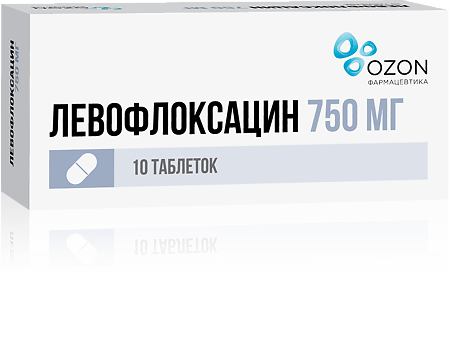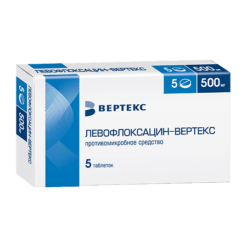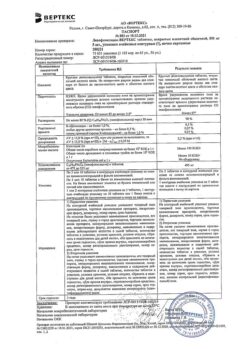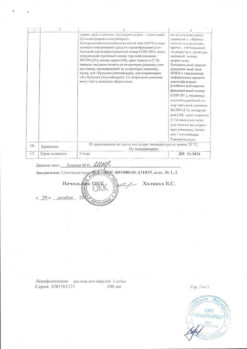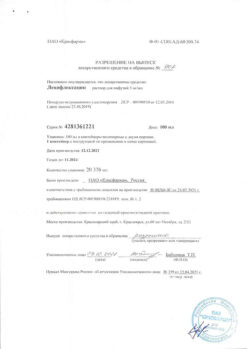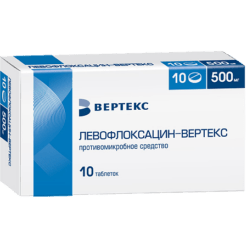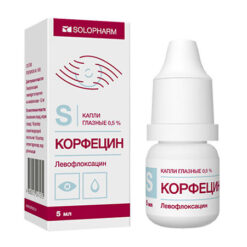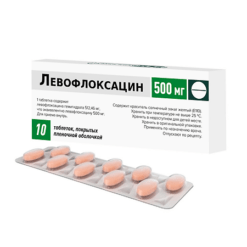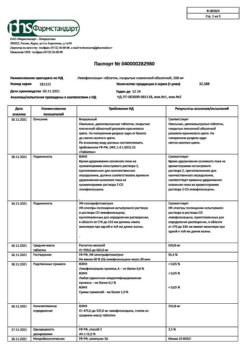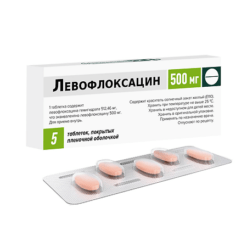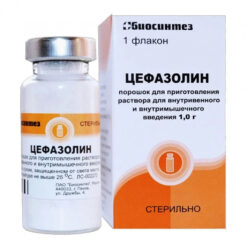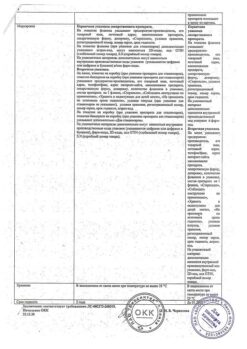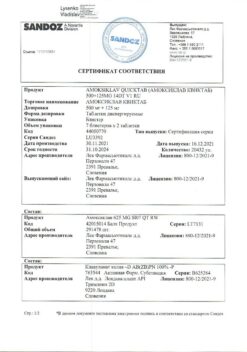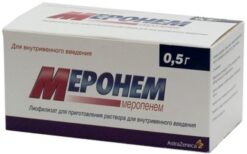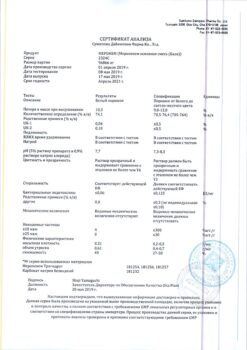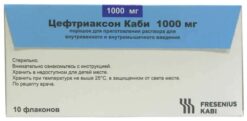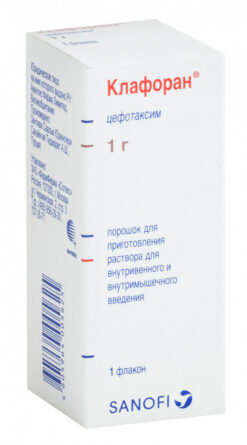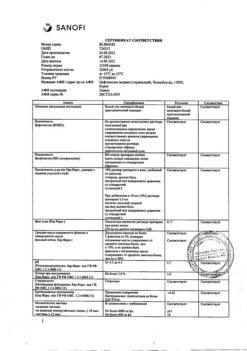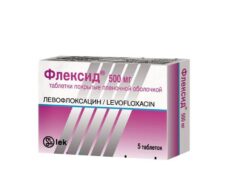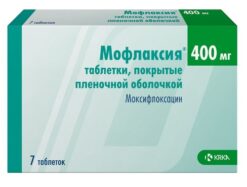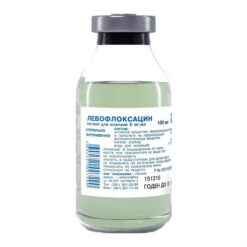No products in the cart.
Levofloxacin, 750 mg 10 pcs
€22.96 €19.90
Description
Levofloxacin
Indications
Indications
Treatment of infectious and inflammatory diseases caused by microorganisms sensitive to levofloxacin: community-acquired pneumonia; complicated urinary tract infections and pyelonephritis; chronic bacterial prostatitis; infections of the skin and soft tissues; for complex treatment of drug-resistant forms of tuberculosis; prevention and treatment of anthrax through airborne transmission.
For the treatment of the following infectious and inflammatory diseases, levofloxacin can be used as an alternative to other antimicrobial drugs: acute sinusitis, exacerbation of chronic bronchitis; uncomplicated cystitis.
Pharmacological effect
Pharmacological effect
Pharmacotherapeutic group: Antimicrobial agent – fluoroquinolone
Pharmacological action
A synthetic broad-spectrum antibacterial agent from the group of fluoroquinolones, a levorotatory isomer of ofloxacin. Levofloxacin blocks DNA gyrase and topoisomerase IV, disrupts supercoiling and cross-linking of DNA breaks, inhibits DNA synthesis, causes profound morphological changes in the cytoplasm, cell wall and membranes of microbial cells.
Levofloxacin is active against most strains of microorganisms both in vitro and in vivo.
Aerobic gram-positive microorganisms: Bacillus anthracis, Corynebacterium diphtheriae, Corynebacterium jeikeium, Enterococcus spp. (including Enterococcus faecalis), Listeria monocytogenes, Staphylococcus coagulase-negative methi-S(I), Staphylococcus aureus methi-S, Staphylococcus epidermidis methi-S, Staphylococcus spp. (CNS), Streptococcus groups C and G, Streptococcus agalactiae, Streptococcus pneumoniae peni I/S/R, Streptococcus pyogenes, Streptococcus viridans peni-S/R.
Aerobic gram-negative microorganisms: Acinetobacter spp. (including Acinetobacter baumannii), Actinobacillus actinomycetemcomitans, Citrobacter freundii, Eikenella corrodens, Enterobacter spp. (including Enterobacter aerogenes, Enterobacter cloacae), Escherichia coli, Gardnerella vaginalis, Haemophilus ducreyi, Haemophilus influenzae ampi-S/R, Haemophilus parainfluenzae, Helicobacter pylori, Klebsiella spp. (including Klebsiella oxytoca, Klebsiella pneumoniae), Moraxella catarrhalis (β+/β-), Morganella morganii, Neisseria gonorrhoeae non-PPNG/PPNG, Neisseria meningitidis, Pasteurella spp. (including Pasteurella dagmatis, Pasteurella multocida, Pasteurella canis), Proteus mirabilis, Proteus vulgaris, Providencia spp. (including Providencia rettgeri, Providencia stuartii), Pseudomonas aeruginosa, Pseudomonas spp. (including Pseudomonas aeruginosa), Salmonella spp., Serratia spp. (including Serratia marcescens).
Anaerobic microorganisms: Bacteroides fragilis, Bifidobacterium spp., Clostridium perfringens, Fusobacterium spp., Peptostreptococcus, Propionibacterium spp., Veillonella spp.
Other microorganisms: Bartonella spp., Chlamydia pneumoniae, Chlamydia psittaci, Chlamydia trachomatis, Legionella spp. (including Legionella pneumophila), Mycobacterium spp. (including Mycobacterium leprae, Micobacterium tuberculosis), Mycoplasma hominis, Mycoplasma pneumoniae, Ricketsia spp., Ureaplasma urealyticum.
Moderately sensitive microorganisms: aerobic gram-positive microorganisms – Corynebacterium urealyticum, Corynebacterium xerosis, Enterococcus faecium, Staphylococcus epidermidis methi-R, Staphylococcus liaemolyticus methi-R; aerobic gram-negative microorganisms – Campylobacter jejuni, Campylobacter coli; anaerobic microorganisms – Prevotella spp., Porphyromonas spp.
Levofloxacin-resistant microorganisms: aerobic gram-positive microorganisms – Staphylococcus aureus methi-R, Staphylococcus coagulas e-negative methi-R, Corynebacterium jeikeium; aerobic gram-negative microorganisms – Alcaligenes xylosoxidans; anaerobic microorganisms – Bacteroides thetaiotaomicron; other microorganisms – Mycobacterium avium.
Pharmacokinetics
Levofloxacin is rapidly and almost completely absorbed after oral administration; food intake has little effect on absorption. Absolute bioavailability when taken orally is 99-100%. After a single dose of 500 mg, Cmax in blood plasma is achieved within 1-2 hours and is 5/2+1/2 mcg/ml. The pharmacokinetics of levofloxacin is linear in the dose range from 50 to 1000 mg. Css of levofloxacin in blood plasma when taken at a dose of 500 mg 1 or 2 times a day is achieved within 48 hours. Plasma protein binding is 30-40%. After a single and repeated dose of 500 mg, the Vd of levofloxacin is, on average, 100 l, which indicates good penetration of levofloxacin into organs and tissues.
Levofloxacin is metabolized to a small extent (5% of the dose taken). Its metabolites are demethyllevofloxacin and N-oxidelevofloxacin, which are excreted by the kidneys. Levofloxacin is eliminated relatively slowly from blood plasma, T1/2 – 6-8 hours. Excretion is mainly through the kidneys (more than 85% of the dose taken). The total clearance of levofloxacin after a single dose of 500 mg was 175±29.2 ml/min.
In renal failure, the pharmacokinetics of levofloxacin changes. As renal function deteriorates, urinary excretion and renal clearance decrease and T1/2 increases.
Special instructions
Special instructions
Hospital-acquired infections caused by Pseudomonas aeruginosa may require combination treatment.
The prevalence of acquired resistance in cultured strains of microorganisms may vary by geographic region and over time. Therefore, country-specific information on levofloxacin resistance is required. For the treatment of severe infections or if treatment is ineffective, a microbiological diagnosis must be established with the isolation of the pathogen and determination of its sensitivity to levofloxacin.
There is a high probability that methicillin-resistant strains of Staphylococcus aureus will be resistant to fluoroquinolones, including levofloxacin. Therefore, levofloxacin is not recommended for the treatment of known or suspected infections caused by methicillin-resistant strains of Staphylococcus aureus unless laboratory testing has confirmed the sensitivity of this microorganism to levofloxacin.
The use of fluoroquinolones, incl. levofloxacin has been associated with disability and the development of irreversible serious adverse reactions from various body systems that can develop simultaneously in the same patient. Adverse reactions caused by fluoroquinolones include tendonitis, tendon rupture, arthralgia, myalgia, peripheral neuropathy, and nervous system side effects (hallucinations, anxiety, depression, insomnia, headaches, and confusion). These reactions may develop from several hours to several weeks after starting levofloxacin therapy. The development of these adverse reactions was observed in patients of any age or without the presence of previous risk factors. If the first signs or symptoms of any serious adverse reactions occur, use of levofloxacin should be discontinued immediately. The use of fluoroquinolones should be avoided, incl. levofloxacin, in patients who have experienced any of these serious adverse reactions.
Like other quinolones, levofloxacin should be used with great caution in patients with a predisposition to seizures: in patients with previous lesions of the central nervous system, such as stroke, severe traumatic brain injury; in patients simultaneously receiving drugs that lower the seizure threshold of the brain, such as fenbufen and other similar NSAIDs, as well as other drugs that lower the seizure threshold, such as theophylline. If seizures develop, treatment with levofloxacin should be discontinued.
Diarrhea that develops during or after treatment with levofloxacin, especially severe, persistent and/or bloody, may be a symptom of pseudomembranous colitis caused by Clostridium difficile. If pseudomembranous colitis is suspected, treatment with levofloxacin should be stopped immediately and specific antibiotic therapy (vancomycin, teicoplanin or oral metronidazole) should be started immediately. Drugs that inhibit intestinal motility are contraindicated.
Tendonitis has been reported rarely with quinolones, including levofloxacin, and can sometimes lead to rupture of tendons, including the Achilles tendon. This side effect can develop within 48 hours after starting treatment and can be bilateral. Elderly patients are more prone to developing tendinitis; in patients taking fluoroquinolones, the risk of tendon rupture may increase with concomitant use of corticosteroids. In addition, post-transplant patients have an increased risk of developing tendonitis, so it is recommended to be careful when prescribing fluoroquinolones to this category of patients.
Levofloxacin may cause serious, potentially fatal hypersensitivity reactions (angioedema, anaphylactic shock), even with initial doses. Patients should stop taking the drug immediately and consult a doctor.
Cases of severe bullous skin reactions such as Stevens-Johnson syndrome or toxic epidermal necrolysis have been observed with the use of levofloxacin. If any reactions develop from the skin or mucous membranes, the patient should immediately consult a doctor and do not continue treatment until consultation with a specialist.
Cases of liver necrosis, including fatal liver failure, have been reported with the use of levofloxacin, mainly in patients with severe underlying diseases, such as sepsis. The patient should be warned about the need to stop treatment and urgently consult a doctor if signs and symptoms of liver damage appear, such as anorexia, jaundice, dark urine, itching, abdominal pain.
Because Levofloxacin is excreted mainly by the kidneys; in patients with impaired renal function, mandatory monitoring of renal function is required, as well as adjustment of the dosage regimen. When treating elderly patients, it should be taken into account that patients in this group often have impaired renal function.
Although photosensitivity occurs very rarely with the use of levofloxacin, to prevent its development, patients are not recommended to be exposed to strong solar or artificial UV irradiation (for example, visiting a solarium) during treatment and for 48 hours after the end of treatment with levofloxacin.
As with the use of other antibiotics, the use of levofloxacin, especially for a long time, can lead to increased proliferation of microorganisms that are insensitive to it (bacteria and fungi), which can cause changes in the microflora that is normally present in humans, which can result in the development of superinfection. Therefore, during treatment, it is imperative to re-evaluate the patient’s condition and, in the event of superinfection developing during treatment, appropriate measures should be taken.
Very rare cases of QT prolongation have been reported in patients taking fluoroquinolones, including levofloxacin.
Patients with latent or manifest glucose-6-phosphate dehydrogenase deficiency are predisposed to developing hemolytic reactions when treated with quinolones, which should be taken into account when treating with levofloxacin.
As with other quinolones, cases of hyperglycemia and hypoglycemia have been observed with the use of levofloxacin, usually in patients with diabetes mellitus receiving concomitant treatment with oral hypoglycemic drugs (for example, glibenclamide) or insulin. Cases of hypoglycemic coma have been reported. In patients with diabetes mellitus, monitoring of blood glucose concentrations is required.
Cases of sensory and sensorimotor peripheral neuropathy, which may have a rapid onset, have been reported in patients receiving fluoroquinolones, including levofloxacin. If the patient develops symptoms of neuropathy, levofloxacin should be discontinued. This minimizes the possible risk of developing irreversible changes. Patients should be informed to report any symptoms of neuropathy to their healthcare provider. Fluoroquinolones should not be prescribed to patients with a history of peripheral neuropathy.
Fluoroquinolones, including levofloxacin, have neuromuscular blocking activity and may increase muscle weakness in patients with myasthenia gravis. Adverse reactions, including pulmonary failure requiring mechanical ventilation and death, have been associated with the use of fluoroquinolones in patients with myasthenia gravis. The use of levofloxacin in a patient with an established diagnosis of pseudoparalytic myasthenia gravis is not recommended.
The use of levofloxacin for the prevention and treatment of airborne anthrax is based on data on the sensitivity of Bacillus anthracis to it from in vitro and experimental studies in animals, as well as on limited data from the use of levofloxacin in humans. The attending physician should refer to national and/or international documents that reflect the collectively developed point of view on the treatment of anthrax.
Psychotic reactions, including suicidal ideation/attempts, have been reported in patients taking fluoroquinolones, including levofloxacin, sometimes after a single dose. If such reactions develop, treatment with levofloxacin should be discontinued and appropriate therapy should be prescribed. The drug should be prescribed with caution to patients with psychosis or patients with a history of mental illness.
If any visual impairment develops, immediate consultation with an ophthalmologist is necessary.
In patients using levofloxacin, the determination of opiates in urine may lead to false-positive results, which should be confirmed by more specific methods.
Levofloxacin may inhibit the growth of Mycobacterium tuberculosis, which may subsequently lead to false negative results of the bacteriological diagnosis of tuberculosis.
Impact on the ability to drive vehicles and machinery
Side effects such as dizziness or vertigo, drowsiness and visual disturbances may reduce psychomotor reactions and the ability to concentrate. This may pose a risk in situations where these abilities are of particular importance (for example, when driving a car, when servicing machinery, when working in an unstable position).
Active ingredient
Active ingredient
Levofloxacin
Composition
Composition
Active substance: levofloxacin
Excipients: microcrystalline cellulose, sodium carboxymethyl starch, povidone K25 magnesium stearate, croscarmellose sodium, colloidal silicon dioxide.
Pregnancy
Pregnancy
Contraindicated for use during pregnancy and breastfeeding.
Contraindications
Contraindications
Hypersensitivity to levofloxacin or other quinolones; epilepsy; pseudoparalytic myasthenia gravis (myasthenia gravis); tendon lesions associated with a history of fluoroquinolones; pregnancy, breastfeeding period; age up to 18 years.
With caution: in patients predisposed to the development of seizures (in patients with previous lesions of the central nervous system, in patients simultaneously receiving drugs that lower the threshold of convulsive activity of the brain, such as fenbufen, theophylline; in patients with latent or manifest deficiency of glucose-6-phosphate dehydrogenase (increased risk of hemolytic reactions during treatment with quinolones); in patients with impaired renal function (required mandatory monitoring of renal function, as well as correction of the dosage regimen); in patients with known risk factors for prolongation of the QT interval (in elderly patients; in women; in patients with uncorrected electrolyte disturbances (with hypokalemia, hypomagnesemia); with congenital long QT interval syndrome; with heart disease (heart failure, myocardial infarction, bradycardia); while taking drugs that can prolong the QT interval (class IA and III antiarrhythmic drugs, tricyclic antidepressants, macrolides, antipsychotics); in patients with diabetes mellitus receiving oral hypoglycemic drugs (for example, glibenclamide) or insulin (the risk of hypoglycemia increases); in patients with severe adverse reactions to other fluoroquinolones, such as severe neurological reactions (increased risk of developing similar adverse reactions when using levofloxacin); in patients with psychosis or in patients with a history of mental illness; in elderly patients, in patients after transplantation, as well as with concomitant use of GCS (increased risk of tendinitis and tendon rupture).
Side Effects
Side Effects
From the cardiovascular system: rarely – sinus tachycardia, palpitations, decreased blood pressure; frequency unknown – prolongation of the QT interval, ventricular arrhythmias, ventricular tachycardia, ventricular tachycardia of the “pirouette” type, which can lead to cardiac arrest.
From the hematopoietic system: infrequently – leukopenia, eosinophilia; rarely – neutropenia, thrombocytopenia; frequency unknown – pancytopenia, agranulocytosis, hemolytic anemia.
From the nervous system: often – headache, dizziness; infrequently – drowsiness, tremor, dysgeusia; rarely – paresthesia, convulsions; frequency unknown – peripheral sensory neuropathy, peripheral sensorimotor neuropathy, dyskinesia, extrapyramidal disorders, ageusia, parosmia, including loss of smell, syncope, benign intracranial hypertension.
Mental disorders: often – insomnia; infrequently – feeling of anxiety, confusion; rarely – mental disorders (hallucinations, paranoia), depression, agitation, sleep disturbances, nightmares; frequency unknown – mental disorders with behavioral disorders with self-harm, including suicidal thoughts and suicide attempts.
From the side of the organ of vision: rarely – visual disturbances, such as blurriness of the visible image; frequency unknown – transient loss of vision, uveitis.
From the organ of hearing and labyrinthine disorders: infrequently – vertigo; rarely – ringing in the ears; frequency unknown – hearing loss, hearing loss.
From the respiratory system: infrequently – shortness of breath; frequency unknown – bronchospasm, allergic pneumonitis.
From the digestive system: often – diarrhea, vomiting, nausea; uncommon – anorexia, abdominal pain, dyspepsia, flatulence, constipation; frequency unknown – hemorrhagic diarrhea, which in very rare cases may be a sign of enterocolitis, including pseudomembranous colitis, pancreatitis.
From the liver and biliary tract: often – increased activity of ALT, AST, alkaline phosphatase, GGT; infrequently – increased concentration of bilirubin in the blood; frequency unknown – severe liver failure, including cases of acute liver failure (sometimes fatal), especially in patients with a severe underlying disease (for example, sepsis); hepatitis, jaundice.
From the urinary tract: infrequently – increased concentration of creatinine in the blood serum; rarely – acute renal failure (for example, due to the development of interstitial nephritis).
From the skin and subcutaneous tissues: infrequently – rash, itching, urticaria, hyperhidrosis; frequency unknown – toxic epidermal necrolysis, Stevens-Johnson syndrome, exudative erythema multiforme, photosensitivity reactions (increased sensitivity to solar and UV radiation), leukocytoclastic vasculitis, stomatitis.
From the immune system: rarely – angioedema; frequency unknown – anaphylactic shock, anaphylactoid shock.
From the musculoskeletal system: infrequently – arthralgia, myalgia; rarely – tendon damage, including tendonitis (for example, Achilles tendon), muscle weakness, which can be especially dangerous in patients with pseudoparalytic myasthenia gravis; frequency unknown – rhabdomyolysis, tendon rupture (eg, Achilles tendon), ligament rupture, muscle rupture, arthritis.
From the side of metabolism: rarely – hypoglycemia, especially in patients with diabetes mellitus; frequency unknown – hyperglycemia, hypoglycemic coma.
Infectious and parasitic diseases: infrequently – fungal infections, development of resistance of pathogenic microorganisms.
General reactions: infrequently – asthenia; rarely – pyrexia; frequency unknown – pain (including pain in the back, chest, limbs); very rarely – attacks of porphyria in patients already suffering from this disease.
Interaction
Interaction
Drugs containing divalent or trivalent cations, such as zinc or iron salts, magnesium and/or aluminum-containing drugs, didanosine (only dosage forms containing aluminum or magnesium as a buffer), are recommended to be taken at least 2 hours before or 2 hours after taking levofloxacin.
The effect of levofloxacin is significantly weakened by simultaneous use of sucralfate. For patients receiving levofloxacin and sucralfate, it is recommended that sucralfate be taken 2 hours after taking levofloxacin.
With the simultaneous use of quinolones and theophylline, NSAIDs and other drugs that reduce the threshold of convulsive readiness of the brain, a pronounced decrease in the threshold of convulsive readiness of the brain is possible.
In patients receiving levofloxacin in combination with indirect anticoagulants (for example, warfarin), an increase in prothrombin time/INR and/or bleeding was observed, incl. and heavy. Therefore, when using indirect anticoagulants and levofloxacin simultaneously, regular monitoring of blood coagulation parameters is necessary.
When simultaneous use of levofloxacin and drugs that interfere with the renal tubular secretion of levofloxacin, such as probenecid and cimetidine, caution should be exercised, especially in patients with renal failure.
Concomitant use of corticosteroids increases the risk of tendon rupture.
Manufacturer
Manufacturer
Ozon, Russia
Additional information
| Manufacturer | Ozon, Russia |
|---|---|
| Medication form | pills |
| Brand | Ozon |
Other forms…
Related products
Buy Levofloxacin, 750 mg 10 pcs with delivery to USA, UK, Europe and over 120 other countries.

